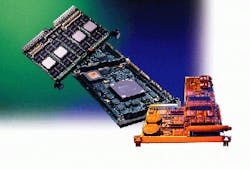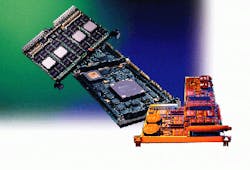Networked DSPs speed data-intensive imaging applications
Networked DSPs speed data-intensive imaging applications
By Rick Nelson, Contributing Editor
Data processing and transfer speeds are two important factors that determine the performance of an image-processing system. As one of the first IC vendors to realize this, Inmos--now part of SGS-Thomson (Lincoln, MA)--introduced the Transputer, a high-performance processor that features on-chip serial links to transfer data between ICs and thus overcome the bandwidth limitations of bus-based systems. Analog Devices (Wilmington, MA) and Texas Instruments (TI; Denver, CO) have developed DSP-based ICs, the Sharc and TMS320CXX family, that use the same principle to allow designers to implement multiple DSP configurations.
Using these processors, many board vendors have introduced products on a number of different buses, which bring multiprocessing DSP performance to applications ranging from medical imaging to synthetic aperture radar. But the high performance of these boards is not solely due to the increased processing performance of the ICs they use. In most cases, the interprocessor, or board-to-board communications systems, have just as important a role to play.
Processor varieties
Analog Devices` Sharc and TI`s TMS320CXX families are wrestling processing business from Transputer, i860, and RISC-based designs. Many board vendors have aligned themselves with one device family in building their products. In the Sharc camp, CSPI and Ixthos offer multiple processing VME boards. For its part, Bittware Research Systems (Concord, NH) offers multiple-Sharc implementations for the PCI and ISA bus.
Pentek (Upper Saddle River, NJ), Ariel (Cranbury, NJ), and Spectrum Signal Processing (Burnaby, Canada) have a long history of TMS-family designs. In addition, the TMS family remains popular among image-processing vendors. Matrox (Dorval, Canada) uses the TMS320C80 in its Genesis PCI board, while the Coreco (St. Laurent, Canada) F/64-PCI image-processing boards are based on the TMS320C40. Precision Digital Images (Redmond, WA) offers a hardware and software image-processing family based on the TMS320C80.
In the VMEbus environment, vendors use a variety of communications schemes to meet the appetites of data-hungry DSPs. Here, the I/O features of DSP ICs are being used for interprocessor communication on PCI mezzanine cards (PMCs) that can accommodate from two to eight DSPs. Pentek (model 4286 VME DSP board) is one company that uses this concept to support two TMS320C80 processors on a PMC add-in module. With a throughput of 5 billion operations per second, the board is targeted at live video and real-time image-processing applications, such as missile-damage evaluation and heat signature detection.
While most board vendors support a single-processor architecture, some support multiple devices. Alacron (Nashua, NH), for example, offers image and signal-processing boards based on Intel`s i860, Sharc, and TMS320C80 DSPs. Consequently, it offers a range of performance options, from the 200 MFLOPS of the i860-based FT-200 series to the 960 MFLOPS Sharc- based FT-Sharc Series and 2 GOPS TMS320C80-based FT-C80.
Other processors are also finding use in attached coprocessor applications. The Gemini DSP board from Catalina Research (Colorado Springs, CO) is a 6U VME board featuring Sharp`s LH9124 floating-point DSP chip set (see figure). The board can process a 1024-point complex FFT at 37.5 Msamples/s. The Genesis board can also interconnect with other Catalina pre- and postprocessing boards for applications in pulse compression, radar and sonar processing.
Interprocessor communication
Fast DSPs alone do not make a high-performance image-processing system. While the TMS320C80`s and Sharc processor`s off-chip data-transfer capability can provide fast processor-to-processor I/O, architectures involving multiple processors distributed across multiple boards crossbar switching methods to optimize off-module and board-to-board communication. Here again, the systems developer has many choices, many of which, such as Ixthos` IXZ, Mercury Computer`s RACEway, and Sky Computers` SKYchannel, are proprietary.
Ixthos`s IXZ interconnect scheme relies on the multiple link ports of the Sharc DSP to move data. The company`s IXZ4 quad Sharc board provides 12 (three per processor) 40-Mbyte/s links and a 160-Mbyte/s local cluster bus interface.
Mercury`s RACEway switched interconnect provides three simultaneous transactions for 480 Mbit/s of aggregate bandwidth per crossbar or 1.6 Gbyte/s per module. Last October , the company ship-ped commercial off-the-shelf RACEway multicomputers for deployment in the US Navy`s Multi-Purpose Processor submarine combat systems. Consisting of 180 microprocessors, the system analyzes streams of sonar data. To provide real-time sensor com- munication between sonar arrays and the RACE multicomputer, the company is integrating a PCI mezzanine interface into the RACE architecture.
SKYchannel incorporates a 10-port crossbar backplane, which allows five simultaneous 320-Mbyte/s data transfers, for an aggregate 1.6-Gbyte/s bandwidth. SKYchannel supports chassis-to-chassis and board-to-board communication.
Myranet for VMEbus
Another interconnect scheme beginning to find use in the VMEbus environment is the Myricom (Arcadia, CA) Myrinet, a switched network that can connect workstations or PCs through full-duplex links at 1.28 Gbit/s. Both Myricom and CSPI (Billerica, MA) are touting this approach as a new ANSI/VITA standard. (RACEway and SKYchannel are already VITA standards.) Alacron is also endorsing Myrinet in its latest VME Octal Sharc board, dubbed Dominator. With an on-board Pentium host processor, developers can interface to the Myrinet by adding a PMC add-on card to the board.
Myranet, a network of ports constructed from cables and crossbar integrated-circuit switches, scales up to any desired size. Unlike Ethernet or FDDI, Myranet`s aggregate traffic capacity increases with the number of hosts. Myrinet packets can be of any length and carry many types or protocols simultaneously, thus supporting several software interfaces, such as TCP/IP and MPI.
The Myranet implementation uses point-to-point cables, with each cable/connector supporting two full-duplex pairs of 160-Mbyte/second channels, yielding a 640-Mbyte/s peak I/O data rate through each cable/connector. The backplane implementation provides 640 Mbytes/s of I/O bandwidth per VME slot via the VMEbus P0/J0 connector. CSPI and Myricom have developed a four-slot overlay switch module that connects eight SAN links, delivering 1.28 GByte/s of I/O bandwidth between four VME boards across P0.
To support Myranet, CSPI has introduced a VMEbus system that combines Myrinet with a Motorola (Tempe, AZ) PowerPC 603 and an open multiprocessing software package based on the Wind River Systems (Alameda, CA) VxWorks real-time operating system and a message-passing-interface library. The system includes CSPI MAP-2610 processor boards and MAP-SW-10 switch boards. Processor boards are interconnected to MAP-SW-10 boards with SAN front-panel point-to-point cables. Other I/O options can be integrated into the MAP platform using third-party PMC modules supported by the MAP-2610 PMC extension carrier.
Higher performance
As processors such as the Transputer and the i860 have lost favor among designers of high-performance boards, DSP board vendors have been left with two choices, the TI TMS320CXX family and Analog Devices` Sharc designs. While some board vendors are choosing TI`s C80-based multiprocessor device for image processing, the IC is, according to a spokesman at Alacron, "more difficult to program than the i860." In the meantime, Analog Devices has introduced a linkless Sharc chip that vendors such as Alacron will use to lower the cost of DSP computing.
Board vendors are paying much more attention to the problems of high-speed networking, a move that can only benefit the systems integrator.
An array of processor and bus choices exist for image processing. Examples include (from top) Ariel`s VME Hyper- Hydra Sharc boards, Coreco`s C40-based F64 PCI board, and Pentek`s PC and VME-based Dual C80 boards.
DSPs make real-time video editing more flexible
Hardware-based video editing systems such as digital video switchers and digital- effects generators lack programmability, making them inflexible and quickly obsolescent. DSP technology has not been powerful enough to handle the 1000-MIPS calculation rate for real-time video, but that situation is changing with the emergence of DSPs such as the Sharc.
Mercury Computer Systems (Chelmsford, MA) is using its DSP experience to develop a programmable system that can handle the 1.7 billion-bit/s throughput that real-time video editing demands. With DSP chips supported by the RACEway ASIC-based crosspoint interconnects, the Mercury Digital Video Server (MDVS) offers scalability and programmability.
Turner Broadcasting has already ordered an MDVS for its CNN Interactive Group (Atlanta, GA) to design and develop news material for the Internet. The MDVS supports several video-editing stations and allows CNN editors to work simultaneously to package CNN programming for display on the Web. With the MDVS system, editors can share video files to produce program content faster and deliver edited and compressed programming directly to the relevant Web site.
DSP BOARD VENDORS- a sampling
Alacron l Nashua, NH l (603) 891-2750 l Fax: (603) 891-2745 l http://www.alacron.com
Ariel l Cranbury, NJ l (609) 860-2900 l Fax: (609) 860-1155 l http://www.ariel.com
Bittware Research Systems l Concord, NH l (800) 848-0436 l Fax: (603) 226-6667 l http://www.bittware.com
Catalina Research l Colorado Springs, CO l (719) 637-0880 l Fax: (719) 637-3839 l http://www.cri-dsp.com
Coreco l St. Laurent, Quebec, Canada l (514) 333-1301 l Fax: (514) 333-1388 l http://www.coreco.com
CSPI l Billerica, MA l (508) 663-7598 l Fax: (508) 663-0150 l http://www.cspi.com
Ixthos l Leesburg, VA l (703) 779-7800 l Fax: (703) 779-7805 l http://www.ixthos.com
Matrox l Dorval, Quebec, Canada l (514) 685-2630 l Fax: (514) 969-6273 l http://www.matrox.com/imaging
Mercury Computer Systems l Chelmsford, MA l (508) 256-1300 l Fax: (508) 256-3599 l http://www.mc.com
Motorola l Tempe, AZ l (602) 413-3615 l Fax: (602) 413-4193 l http://www.mot.com
Myricom l Arcadia, CA l (818) 821-5555 l Fax: (818) 821-5316 l http://www.myri.com
Pentek l Upper Saddle River, NJ l (201) 818-5900 l Fax: (201) 818-5900 l http://www.pentek.com
Precision Digital Images l Redmond, WA l (206) 882-0218 l Fax: (206) 867-9177 l http://www.precisionimages.com
Sky Computers l Chelmsford, MA l (508) 250-1920 l Fax: (508) 250-0036 l http://www.sky.com
Spectrum Signal Processing l Burnaby, BC, Canada l (604) 421-1764 l Fax: (604) 421-1764 l http://www.spectrumsignal.bc.ca

